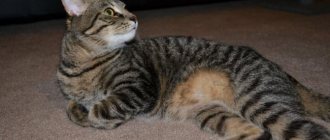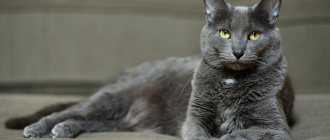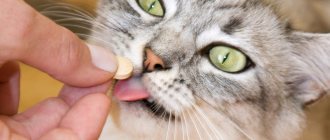“Mom, let’s buy a kitten!” — it is with this phrase that many families begin their acquaintance with furry purrs. However, not all parents think it’s a good idea to have a cat for their child. But are mustachioed and striped animals as dangerous for children as they are imagined to be?
- 2 How to properly raise a cat and a child
2.1 How to choose a cat for a child2.1.1 The best and worst cat breeds for children
- 2.1.2 Photo gallery: cat breeds for children
Which cat is best for a child?
Each cat breed has its own characteristics, which it is better to know about in advance, and its own character. If there is a child in the family, it is of course better to choose a cat among non-aggressive, friendly, playful breeds. Before purchasing, familiarize yourself with the characteristics of the breed and prepare for possible difficulties.
If you have decided on a breed, pay close attention to the breeders . Unfortunately, there are now more and more people who are trying to make money from breeding without caring about the health of the animals. A low cost may indicate that the animal was raised in poor conditions and fed cheap food, without veterinary control, or the kittens were the result of inbreeding. Such cats can have a number of serious defects and diseases.
It is important for parents to remember: no matter what animal they get, they must carefully monitor the health of their pet. Firstly, we are responsible for those we have tamed, and secondly, our smaller brothers themselves can become carriers of some diseases dangerous to humans if basic prevention rules are not followed.
Be sure to visit a veterinarian for a preventive examination and vaccination at least 1-2 times a year. At least 2 times a year, you should drive away worms with special means: even if the cat sits in the apartment forever, you yourself can bring helminth eggs or dangerous viruses from the street on your shoes. When going outdoors, don’t forget to treat your fur against fleas and ticks.
It is also better to immediately discuss with your doctor the method and timing of sterilization of the animal : this will protect the cat from a number of diseases and improve its disposition. Teach your child to always maintain hygiene and wash their hands after contact with an animal. A healthy cat can become a true friend to you and your children and a full member of the family for many years.
The benefits and dangers of a cat for a child
The first question parents ask before getting a kitten is the issue of safety. You can find many arguments online against cats for children. It is believed that cats are more aggressive and intolerant than dogs. However, this opinion is generated by people who do not want and do not know how to raise either themselves or their children.
A cat as an animal for children has many advantages and disadvantages:
- The cat is quite independent, so it will teach the child not only love, but also respect for animals.
- A cat requires less attention than a dog, so it is perfect as a first pet for a small child.
- From childhood, a cat will teach a child responsibility: it must be fed, the water in the bowl must be changed daily, these bowls must be washed, and traces of the cat’s pranks must be removed.
- The cat will instill in the child the skills of proper handling of animals.
- A cat helps children cope with stress more easily and without lashing out at the weaker one. Children who communicate with a cat will never become aggressive or capricious.
- A cat, oddly enough, makes the child much healthier. Scientists have proven that having a cat in the house prevents the development of asthma. If a child does not have a congenital allergy to animal fur or saliva, then this disease will bypass him if he has been in contact with a cat since childhood. In addition, children who are constantly in contact with cats develop an immune response, thanks to which they are much less likely to suffer from colds and infectious diseases.
Cats are great for dealing with stress
Remember that your cat must be vaccinated annually, wormed every three months, and treated for fleas and ticks every 2 months.
Of course, there are risks in living next to a cat:
- If a cat often walks outside, it can bring some kind of infection. Therefore, a cat for a child should only be domestic.
- Cat worms are also dangerous. However, this problem can be solved: it is enough just to give the cat anti-worm medications every three months and regularly give the child and all family members an anthelmintic.
- The cat may severely scratch or bite the child. Most often this happens not through her fault, but through the fault of the child. There are also cases when a cat has mental problems, but this is rare.
- There is such a thing as cat scratch disease, which is caused by microorganisms from under a cat's claws. When it occurs, the scratch swells and the temperature may rise slightly. In children with weak immune systems, it can lead to a mild fever. Therefore, all scratches must be quickly treated with iodine or brilliant green.
The danger of cats to children is often exaggerated
British Shorthair
When thinking about what breed a cat should be - a friend and playmate for children, many felinologists (cat specialists) give a clear answer: British.
This breed includes long-haired and short-haired animals, but a pet with a plush coat and short hair is more suitable for children. According to legend, the famous Cheshire Cat was a British Shorthair.
Britons are companion cats. Play? Yes. Sleeping in an embrace with the owner? Yes too. This breed is not phlegmatic, but has a balanced, calm temperament. It is very difficult to anger a Briton; aggression is not characteristic of him.
The advantage of this breed is self-sufficiency. Animals are not annoying and do not require constant attention. They have excellent intelligence, and over the years they develop their own opinions on various matters.
This is an ideal option for keeping in an apartment: the British are clean, and for maintenance it is enough to comb their fur coat once a week.
British shorthair cat breed
You simply cannot find a better cat for home than this breed. This cat is suitable for any age and will become a real companion for both large and very small children. British cats have excellent intelligence and are unpretentious in care and maintenance. The main feature of the British is their independence and independence.
The British feel equality in the family, whether it is an adult or a child . Experienced owners of such breeds note the absolutely identical attitude of the animal to the person, that is, the better the child or adult treats the animal, the more responsive, affectionate and kind the cat will be.
© shutterstock
Be sure to involve your child in the choice, do not give a personal gift - a pet
Also pay attention to the character, temperament of your baby, whether he has diseases (for example, an allergy to wool), the size of the apartment, income (some breeds of cats require certain and obligatory expenses). All worries will still fall on you, think about it - do you need this? Or is it easier to refuse your child? If your answer to the first question is yes, then move on to our rating of kitten breeds for your children!
The oldest cat breed in the world, the Persian is a loyal, gentle, non-obsessive, and affectionate pet with a balanced character, who loves to sit in arms and cuddle. The owners note a certain patronizing and condescending attitude on the part of the pet. Not suitable for noisy hours, for children and adults with allergies; they constantly need to take care of the coat, comb out tangles, while at the same time receiving a portion of communication.
Life of a furry in an apartment
In addition to the contact between children's and cat's characters, when buying a kitten, the owners will also receive a “all the best” section with the new roommate.
Most cat owners living in high-rise buildings are concerned with the question: how to fit the free spirit of a cat into a cramped apartment? That is, for a person it may not even seem cramped at all. But only until it turns into a playground for the cat.
To prevent a cat from feeling like a prisoner of four walls, city dwellers need to pay attention to breeds that adapt well to life in big cities.
British shorthair cat
For this breed, home is not the most important thing. Such a cat attaches more importance to communication with humans and the cat’s inner harmony. Therefore, this breed adapts perfectly to almost any living conditions. Also, these cats are able to adapt to moving and survive repairs painlessly.
Persian cat
The most popular furry creature adapts perfectly to the urban lifestyle. The Persian is absolutely not embarrassed by cramped conditions, and for harmony in life he only needs the attention of his owner.
Persian Murks are very friendly and loyal. Having chosen a “favorite” owner, such a cat will be a faithful companion to a person in any conditions. As they say, “there’s heaven in the hut with the darling.”
Russian blue
This pet, on the contrary, is independent and reserved. Such a cat is not embarrassed by the absence of a person, so it is perfect for busy city dwellers. Murka won't get bored alone. The only condition is a carefully prepared lunch, which she will eat in her free time from her cat affairs.
Scottish Shorthair
Thanks to a gene mutation, humanity received a new breed that quickly gained popularity, and for many people the question of which cat is best to get for a child has only one answer.
Scottish Folds are real cuties with an excellent character, ideally adapted to the modern person.
Kittens are playful and tame from birth. Children love that Scots are easy to train and you can play ball with them and watch TV. They know how to stand on their hind legs - this is a normal manifestation of interest on their part. Tired of children's noise, the cat simply hides - aggression is not typical for her.
Very socialized animals, they have a calm character, do not require constant attention, and respect the human right to solitude.
It is believed that the Scots choose their owner, and simply love the rest of the family members.
It is convenient to keep such a cat in an apartment: it does not make loud sounds, is very clean, quickly understands the rules of behavior and follows them. Care is simple: just brush the animal regularly, wash the eyes and clean the ears.
Due to a gene mutation, cats do not have very strong joints, and owners need to remember this.
The best breeds for children
It is advisable that parents do not give their child a long-awaited pet, but choose it together.
Important! There are a number of breeds that breeders have been working on for a long time, selecting and purposefully developing qualities that are important for life in a family, in an apartment - a guarantee that the character of a cat is easy to predict, it quickly adapts to the home and over the years becomes an excellent companion for a child.
What qualities are valued in an animal destined to become a friend and grow up with a baby?
| Patience | Children can accidentally hurt the cat. Many cat breeds take this calmly, realizing that a human cub is not an aggressive enemy. |
| Low level of territoriality | At the genetic level, cats strive to protect their territory, but a cat in the house must understand that people, even small ones, are above it in the hierarchy. |
| Activity level | Of course, playful breeds are suitable for children and are fun to play with. A passive animal that sleeps most of the time will not suit children. The cat should enjoy interacting with humans. |
| Lack of defensive-aggressive reaction | When frightened, a cat may scratch or bite. This is a normal reaction. But animals that specifically lie in wait for a person and attack from around the corner are not suitable for children. Vicious and aggressive cat breeds are very rare, but it is still worth excluding them from the list. |
| Stress resistance | Yes, children are noisy, so the animal must have a high level of stress tolerance. A timid or nervous pet will not get along in a family with children. |
It is worth considering in detail those breeds on which breeders have worked well.
Tips for choosing
If you want to have a cat in your apartment, then you need to think about the most suitable breed, especially if there is a child in the house. Among the most favorable exotic cats recommended for a home where children live are:
In order to choose a good cat that will be friends and play with the child, will not offend him in any way, and will get along with the rest of the household, you need to take a responsible approach to the selection of the breed and the upbringing of the kitten. When purchasing a small furry friend, it is best to take with you an experienced veterinarian or cat specialist who will immediately identify congenital abnormalities or abnormal behavior of the animal. If this is not possible, then after purchasing it is worth taking the kitten to the veterinary clinic and having a full examination done in order to safely allow the pet to see the child.
Outbred
It is unknown what character traits a cat adopted from the street or from a shelter has. She may turn out to be a playful fidget, a calm aristocrat, or a feisty one.
However, most often, street kittens quickly become attached to a person and accept the rules of behavior in the apartment.
Such cats are not very sociable - this is fixed at the genetic level. But the former homeless animal is self-sufficient, not annoying and unobtrusive. At the same time, an even, warm relationship is built with children, but the kitten is unlikely to allow itself to be commanded.
After adopting an animal from the street, owners need to do a full veterinary examination.
Canadian Sphynx
Canadians are just one of the breeds of so-called hairless cats. There are also Don Sphynxes and Peterbalds.
The statement that sphinxes cannot be a source of allergies is incorrect, because... The allergic reaction is caused by saliva, not fur.
The appearance of sphinxes is peculiar, and many people do not like it, therefore, when deciding what breed of cat to get, you need to be sure that the child will not be scared and will like the “bald” one. One of the features of the Sphinx is its hot, silky skin, very pleasant to the touch.
Sphinxes have high intelligence, but a lot depends on proper upbringing. You can’t shout or scold a cat, just explain to it - the sphinx quickly learns the rules of behavior in the apartment. These animals are not vindictive, patient and usually choose one owner, perceiving other people as friends.
Sphynx cats do not tolerate loneliness well: they like to sit on your hands or knees, but do not impose their company, they are not averse to playing and jumping - a height of more than a meter is not the limit for them.
Caring for a cat without hair is simple: you need to regularly wipe it and wipe its eyes.
A distinctive feature of sphinxes is increased heat transfer, which is why the animals get very cold and require special clothing.
Cat or cat?
The decision has been made: a kitten must appear in the house urgently. The breed has been determined, the tray and food have most likely already been purchased. All that remains is to decide: girl or boy?
What is the difference between the temperament of a cat and the temperament of a cat?
| Cat | Cat |
| Manifestations of “tenderness” occur less frequently. If you need a non-intrusive pet, feel free to buy a cat. | Bouts of caressing occur more frequently. Cats love to sit on laps, purr and be close to their owner. |
| Cats are the masters of the territory. Every corner of the house will be carefully checked with daily walk-throughs. The cat’s consciousness is aimed at the safety of the home: not a single mouse should slip into its abode. | They direct most of their attention to their owners. Contact and interaction are important to them. While the cat will chase imaginary offenders, the kitty will prefer “communication” with a person. |
| With constant surveillance, the cat does not always have time for himself. Boys are less clean and prefer not to waste energy on endless washing. | They love to make a mess. This is the third most important activity (after eating and sleeping) on which Murkas spend all their free time. |
| An adult cat will most likely mark his possessions with “tags.” If the pet will not participate in procreation, then in order to avoid foreign odors it is better to castrate it. | Kitties do not mark territories, however, they actively strive to continue the race. The result of this desire is “songs”, which are performed very often by young animals. If the owners do not plan to breed kittens, then it is better to sterilize the cat. This will save her from suffering over unfulfillment. |
Otherwise, the character and habits of the pet largely depend on the breed and personal characteristics, regardless of gender. Therefore, it is better to choose a kitten not by gender, but by its behavior when meeting its future owners.
Ragdoll
Ragdoll is a blue-eyed miracle.
This breed was registered in the 1960s. Breeders claim that this is one of the cutest and most gentle cats. They follow their owner like dogs. And they are not irritated even by the pestering of small children - they never use claws or teeth in games. However, when getting a ragdoll, you need to be prepared for the fact that their luxurious coat will require regular care.
Abyssinian
It is believed that this is what the cats of the ancient Egyptians looked like, images of which are found in the tombs of the pharaohs. The breed appeared in Europe in the 19th century.
These are intelligent and active animals. They cannot stand boredom and always find something to do, being present wherever something is happening. If the owner communicates little with the animal and does not play, the Abyssinian begins to play pranks.
They love to communicate with children, treating them condescendingly, but it is important for children to understand: the Abyssinian, unlike other cats, can and wants to determine the rules of the game himself. It is better not to allow children under 3-4 years of age to approach these cats.
The apartment is a bit cramped for cats; they need a spacious play area to play.
Siamese
Siamese are called dogs in cats' skin. This breed has an interesting feature - its voice: Siamese are able to change the pitch and tone of sound due to the structure of the vocal cords. They need physical contact, so they are sociable and playful.
This is a good friend for children, because the Siamese cat can be trained, it loves active movements and bustle. If a Siamese takes a child under his wing, he will protect and love him until the end of his days.
The Siamese have no equal in their ability to achieve their goals, even the most mischievous ones. They love to jump and move around on top, so a play area with high platforms should be made for them in the apartment.
It is believed that Siamese cats are vindictive and take revenge for insults, but this is a myth, because excellent long-term memory is characteristic of all cats: they are able to remember throughout their lives what impressed them.
A short-haired Siamese only needs to be brushed occasionally; it can be taught to swim from childhood - these cats love to swim in warm water.
Long-haired varieties of Siamese are the Balinese and Burmese cats.
Which breeds are better not to choose?
If a pet is needed in the house as a playmate for a child, special attention should be paid to the interaction of the animal with people.
What breed of cats are not chosen for children:
- Ragdoll. Genetically fixed incredibly calm temperament. It is very difficult to make such a cat play and run. She is not aggressive, but overly melancholy.
- Persian. These cats are irritable and dislike noise and children's activity. If you force your dog to play, he may bite.
- American Curl. Friendly and playful, but this breed is not suitable for children - Curls do not like cuddles and children's hugs.
- Himalayan. Not suitable due to its long, beautiful coat, which requires considerable effort to tidy up.
- Turkish Angora. Prefers the company of adults, communicating with them through sounds.
All long-haired breeds for children are not an ideal option, because during play the hair will be in the child’s mouth, and the injured animal will begin to show aggression.
Important! Children do not need representatives of recently bred breeds with loose character traits.
A Ragdoll cat will respond well to a child’s calm and even temperament.
A rag doll (this is how the name of the breed is translated) is an affectionate, kind fluffy nanny! There is only one “but”, due to the lack of the ability to group when falling, you cannot throw the cat or, especially, drop it!
Another option is the Burmese cat, a loyal friend and ally with intelligent manners. Sometimes there is a feeling that Burmese pets are created for joy and love for the owner! An important point of maintenance is mandatory daily communication with everyone living in the house; even guests must show friendliness and respect for the cat by picking it up and stroking it. Independence is one of the characteristics of Burma. They treat children as friends and colleagues in games, tasks, and development. Very little babies are Burma's favorites, she will worry about them like kittens!
The Maine Coon breed for children is an excellent option for sociable, friendly and intelligent children. Yes, the size for a cat is gigantic, but what a sociable and sociable pet. The Maine Coon is indifferent and cold to strangers. Only a person who constantly communicates with a pet can evaluate its character. Love and tenderness, devotion and lack of attachment to a place - these are the definitions given by the owners of Maine Coons.
An independent and reserved breed, the British Shorthair bonds with a child with genuine feelings, interest and devotion. In addition, it is easy to repair and move. What is important to her is the love and attention of the owner, internal harmony, and not a home environment.
The calmest and kindest cats
Many people prefer to have purebred cats. Among the huge variety of breeds, how can you choose the one that is best suited for living in the same apartment with your child?
There is a rating of representatives of the cat family, as if specially created for families with children. It includes Ragdoll, Devon Rex, Munchkin, Oriental, Scottish Fold, Siberian, Russian Blue, Burmese and hairless cats.
Ragdoll - a “rag doll” for a baby
This is the undisputed leader in the list of the best cats for children. The Ragdoll takes an honorable third place among the largest domestic representatives of this family. Only the Savannah and the Maine Coon are larger. Due to their low muscle tone, these cats have the unique ability to literally go limp in a hug. It is thanks to this feature that they got their name - from English it translates as “rag doll”.
Top cat breeds for children
We invite you to familiarize yourself with the breeds that are best suited for children.
Non-aggressive
Cats with an easy-going character and absolutely devoid of aggression will become the best companions for little naughty girls.
Abyssinian
Abyssinians are active, curious and incredibly playful cats . They are ideal for the role of favorite friends for children. These animals are real fidgets; they cannot stay in one place for a long time. Sometimes it seems that they have batteries hidden inside them with an endless charge.
Abyssinian cats happily explore the apartment up and down with the baby, run races and come up with the next prank. Cats are famous for their limitless patience : they prefer not to respond to children’s attacks, but to sit out the attack of increased activity in a secluded corner.
Ragdoll
Ragdoll - "rag doll". This is how the name of the breed is translated from English. This cat is the ideal companion for a child. Absolute patience and a complete lack of aggression makes her an ideal furry nanny. Kids can do whatever they want with her, except outright bullying, of course. In your hands, cats become limp and spread out like butter dough.
Ragdolls have one physiological feature - they do not know how to group, so children need to be explained that throwing a pet from a height is prohibited.
British Shorthair
The British cat is a popular breed among families with children. This English aristocrat is phlegmatic to the point of impossibility, has excellent self-control, reacts restrainedly to children's pranks and rarely lets out her claws . The “British” become more attached to children than to adults; they watch their movements with genuine interest, take part in games and share their dreams.
British Shorthair
Angora
The Turkish Angora is a long-haired breed that is often confused with the Persian. This is a lively, sociable and intelligent cat, with a calm and gentle disposition, and is highly adaptable to the environment. The breed is suitable for families with children and will become a cheerful companion for older people. The Angora is a self-confident and self-sufficient cat, but at the same time it needs human attention and does not like loneliness.
Turkish Angora
Persian
There are many rumors about the origin of the Persians. Felinologists suggest that Asian steppe and Asian desert cats participated in its breeding. Compared to other breeds, Persians show the greatest degree of domestication . They have long forgotten how to catch mice and live outside a human home. Persian cats are very affectionate and trusting, and their loyalty is compared to the loyalty of a dog.
Persians resemble a toy thanks to the funny expression of their muzzle. Their fur is soft and fluffy, like that of a teddy bear. Cats easily get along with children, do not scratch or bite, and love to play with them .
Burmese
Burma is a charming, fluffy, blue-eyed beauty with a soft, pliable character. She is affectionate and playful, loves to sit on laps, but will not get underfoot if the owner is busy.
Burma is ideal for families with children due to its calm and balanced character . Fluffy fur is easy to care for; it does not fly around the apartment in clumps if you comb it out with a brush once a week.
Hypoallergenic
There is an opinion that there are cats in the world that do not cause allergies, but this is not true . The Fel D1 protein (Laden allergen), contained in the physiological secretions of cats: saliva, sweat, urine, sebum, is responsible for the development of an allergic reaction.
Some felines produce less protein . These include animals without a plush undercoat, hairless breeds and cats with curly hair. The latter are less likely to lose hair.
Hairless cats also secrete Fel D1, but the physiological secretions are more easily removed from the skin.
Hypoallergenic cats include cats with snow-white fur . They emit fewer allergens compared to dark ones. In addition, females are less allergenic.
Bengal
The Bengal cat is strong, athletic, muscular and flexible , has large oval eyes and fleshy paws, short, silky fur of marbled or leopard color, gray, red and white.
Cats are suitable for families with children due to their relative hypoallergenicity - their fur hardly sheds. They are active, intelligent and quick-witted, love to bask in attention, are friendly towards children and know how to establish relationships with all household members.
Reference. Bengals love to bathe in water, and their favorite pastime is watching water flow from the tap.
Neva Masquerade
The Neva Masquerade is a breed that was bred artificially, but the cats were not crossed with other breeds. A distinctive feature is bright blue eyes, light fur and a bushy tail . Due to its light coat and minimal levels of Fel D1 in saliva, urine and sweat, the breed is considered hypoallergenic. Cats get along well with children and can become affectionate nannies for them.
They love to communicate and be the center of attention, and always support the child’s initiative to play a fun game. The Neva Masquerade is not afraid of water, can swim, climb trees and catch mice. Therefore, the best toy for them will be a wind-up mouse.
Cornish Rex
The Cornish Rex was named so for its similarity in color to the Rex rabbit. These are delightful cats with a playful and affectionate disposition, unusually dexterous, active, and strong . Despite their graceful physique, they have powerful muscles.
Distinctive features of the breed are a wide head, curly hair and curly mustache. Cats are extremely intelligent, have canine-like habits, learn tricks quickly and can be great company for children in fun games.
Elf
The Elf is a breed with a unique appearance, but in many ways similar to other hairless felines . Breeder Karen Nelson suffered from an allergy to cats, but with the advent of the elf, she noticed that the unpleasant symptoms disappeared.
Elves are crossed with Canadian Sphynxes, but crossing two elves is considered more valuable in order to maintain the breed standard. Elves have a soft and affectionate disposition. They are friendly towards children, love to be cuddled, cuddled and kissed .
Sociable
There are silent cats, for example, the Scottish Fold. Instead of meowing, they quietly make funny sounds when they want to communicate with their owner. But there are others, vocal and sociable, who like to chat and argue with people.
The most famous talkers are the Maine Coon, Oriental and Siamese cats . In addition, these breeds are suitable for families with small children.
Maine Coon
Maine Coons are known for their impressive size and desire for dominance. However, these animals treat children with special reverence. Maine Coons carefully guard children, and love to play outdoor games with older children .
The stern look of the Maine Coon reveals that he is a self-confident cat. A distinctive feature of the breed is its long and bushy tail , which cats wrap around their bodies to keep warm in cold weather.
These graceful beauties become strongly attached to their owners, but at the same time remain neutral . They do not need constant attention, but love to lie close and participate in household chores.
Oriental cat
Exotic appearance and wonderful character have made the Oriental cat a favorite of children. Representatives of this breed are hyperactive, so they will tirelessly play their favorite children's games . Animals rarely use their claws, which is why parents need not fear for their babies.
Orientals are affectionate cats that need a lot of attention . They love to talk and make a whole range of sounds that children will love.
Siamese
Siamese cats are real talkers, distinguished by their recognizable shrill, loud and squeaky voice. Cats love to move a lot, chase the mouse, catch candy wrappers on a string. Siamese cats are very trusting and loving, they become very attached to all family members and do not like to sit alone.
Rumors about the evil and vengeful nature of these animals are highly exaggerated. Much depends on human behavior. In a loving family, cats feel needed and are ready to give their warmth to others. Siamese behave calmly and friendly with children and are ready to support any children's pranks .
General tips and tricks
Having decided which cat is best to get for a child, you need to carefully consider the issue of choosing a specific kitten.
How to choose:
- Age. If it is difficult to determine the age of a street kitten, then you need to buy an animal from a nursery that is 8-14 weeks old. At this age, the kitten begins to be accustomed to adult food, it is sufficiently socialized, it is easy to accustom it to the toilet and the rules in the apartment.
- Health. You need to look under the tail: the anus should be dry and clean. Health criteria: eyes and ears without discharge, clean shiny fur, belly is round, but not tight or sunken.
- Behavior. A healthy kitten should be playful, curious, and active. A cat that is too cocky or too quiet means problems with upbringing in the future.
You need to pick up the kitten you like and look at its reaction. Lack of aggression, calmness and a share of healthy curiosity is right.
If the kitten is interested in its future owners, it is possible that it was for them that it was born.
How to properly raise a cat and a child
It often happens that people, seeing a cute kitten, bring it home, and children, not knowing how to handle the animal, can suffer from the sharp claws and teeth of a frightened cat. As a result, the child ends up in a shelter or on the street, and in the worst case, the child receives psychological trauma.
In order to avoid a negative relationship between a child and a cat, it is necessary not only to choose the right cat, but also to instill in the child a respectful attitude towards the animal:
- First of all, explain to the child that the kitten is not a toy, it is also alive and is also afraid and in pain.
- Teach how to properly handle a cat. Explain that you cannot hit, throw, pull the animal by any part of its body, shout at it or try to scare it. You need to talk to the animal calmly and affectionately, stroke it carefully, and it’s better not to pick it up at all, since not every cat will like it.
- Tell us how to understand the mood of a cat: for example, that if an animal hisses, presses its ears, or tries to run away, you should not annoy it with your attention.
- If the child himself expresses a desire to have a cat, then tell him about the responsibility for the animal: feeding, caring for and cleaning after it.
- Explain the rules of hygiene: after each interaction with an animal, you must wash your hands with soap.
- Of course, all such conversations must be supported by parental example. Take your child to friends who have a cat, or to a petting zoo. Show how to properly treat animals.
A child raised to love animals will most likely not experience difficulties communicating with a cat.
It is this approach that will prepare the child for the arrival of a new family member and protect both of them from unwanted injuries. A child should be taught this way from early childhood, as soon as he begins to understand the world around him. As a rule, this is 2–2.5 years.
A child should not get a cat until at least 3–4 years of age, since before this age children have developed a grasping reflex and can unknowingly frighten the animal. The ideal age to get a pet is 5–6 years. It is at this age that the child knows all the rules of hygiene and has an understanding of responsibility and proper attitude towards animals.
Of course, it is necessary to educate the cat itself:
- First of all, she must understand from childhood that scratching and biting people is prohibited. When a kitten scratches or bites during play, immediately stop interacting with it and leave their room. He will quickly understand what he is doing wrong. The child should do the same. But under no circumstances hit the cat or yell at it.
- Together with your child, accustom your cat to the litter box, scratching post, and necessary procedures such as washing and brushing.
- Be sure to show the cat that she is loved in the house, but the child is more important than her. Then there will be no jealousy either on the part of the cat or on the part of the child.
It depends only on the parents whether the cat and the child will become friends.
Remember that you are an example for your child, so you yourself must prepare for the arrival of a new family member. Read articles or books about pet care to learn how to properly handle a cat and teach your child the same.
How to choose a cat for a child
First of all, remember: you shouldn’t skimp on a pet . It is better to choose a purebred cat, whose character and habits are much easier to predict than the character of a mongrel cat (although the cat’s upbringing is also important). Also, a purebred cat from a responsible breeder will definitely be healthy. In addition, street cats, as a rule, have little contact with humans and are not socialized in the same way as kittens from a nursery.
How to choose a cat for a child:
- When meeting kittens, take a closer look: they should be active and playful, not shy, easy to contact, curious and non-aggressive.
- The kitten must be healthy: with clean eyes and a dry nose, shiny fur, a firm and confident gait, skin without wounds or dandruff, and a tummy that is not swollen. The veterinary passport contains a note about vaccinations and anthelmintic course.
- Cats, as a rule, are more graceful, kinder and more affectionate than cats. Cats are more solitary, but more active. But here you should take into account the child’s character: a cat is suitable for noisy, active children, but calmer ones can get a cat.
- For younger children, it is better to get a short-haired cat so that they do not grab its fur. But long-haired cats are also suitable, provided that the child is explained how to handle them correctly.
Respect for an animal is the key to a good relationship with it.
You should not pick up a kitten at a bird market or from your hands. The safety of the child and the health of the pet are much more important than unjustified savings.
The best and worst cat breeds for children
There are also breeds that are more human-oriented than others, warm-tempered and non-aggressive, and therefore more suitable for children:
- Burmese cat. These are some of the best “nannies” in the cat world. Their main advantages are intelligence and friendliness. They are not too playful, but are incredibly patient and affectionate.
- Oriental cat. The energy charge of these purrs is endless! They are ready to spend their days playing games. In addition, they are very friendly and do not tolerate loneliness. They are ideal for both hyperactive and calm children: the former, oddly enough, calm them down, and the latter, on the contrary, force them to show more emotions. In addition, Orientals are easy to train.
- Exotics. They are, without exaggeration, VERY affectionate and become attached to their owner once and for all. However, they do not like excessive fuss and noise, so they are suitable only for calm children.
- Russian blue cat. A real aristocrat, at the same time playful, loving and patient. A child should treat this cat only with care and respect, and then he will not find a better friend.
- Canadian Sphynx. A hairless, vulnerable Canadian is worth purchasing for an older child. He is very affectionate, does not like loneliness and is ready to support his owner in all matters. He will undoubtedly be a wonderful friend for a child. However, you need to remember that caring for a Canadian will be a little more difficult than caring for a cat with a regular coat.
Cats are wonderful friends for children
- Maine Coon. A good-natured giant, he perfectly senses the mood of his owner: he can play and lie in his arms. Suitable for older children - from 6-7 years old. In addition, he can be trained to use a leash and sometimes be walked with the child.
- Kurilian Bobtail. The Kurilian Bobtail is great with children. He seems to take the kids for his “kittens” and allows them a lot. Some bobtails that are particularly attached to a child can even show concern for him: they do not leave a single step, purring at his side, helping him to fall asleep.
- Cornish Rex. These cats with an alien appearance are affectionate and do not like to be alone, in addition, they are unusually smart and patient. Children are the best playmates for them.
Which cats should not be adopted by a child?
- British. Very often you can find them in the tops of the best breeds for children. But these cats are very independent, do not like to be cuddled, and are not very people-oriented. The child will simply annoy them.
- Any hybrid cats: Chausie, Savannah, Caraquet. Bengal and others. They have a much stronger wild side than other breeds.
- The Abyssinian cat and its long-haired relative, the Somali. Constantly included in the tops of the best for children. They are playful and affectionate, but are more suitable for teenagers than small children, as they are vengeful and demand respect.
- Siamese and Mekong bobtail. The Siamese and Mekong have a bad reputation, which is greatly exaggerated. But they are still not suitable for small children.
Useful properties of cats
A furry pet is not only a responsibility and a chore, as future owners think, but also a huge benefit for the child. There are a huge number of beneficial factors from cats, these include:
- A four-legged pet can teach a child responsibility not only for himself, but also for people close to him;
- Babies who grow up next to cats rarely get sick, and, as a rule, are less prone to allergic reactions;
- At a certain age, a child simply needs a four-legged friend, because furry pets are natural antidepressants;
- Pets that are with the baby not only during the day, but also at night, can have a positive effect on the psycho-emotional state during sleep.











